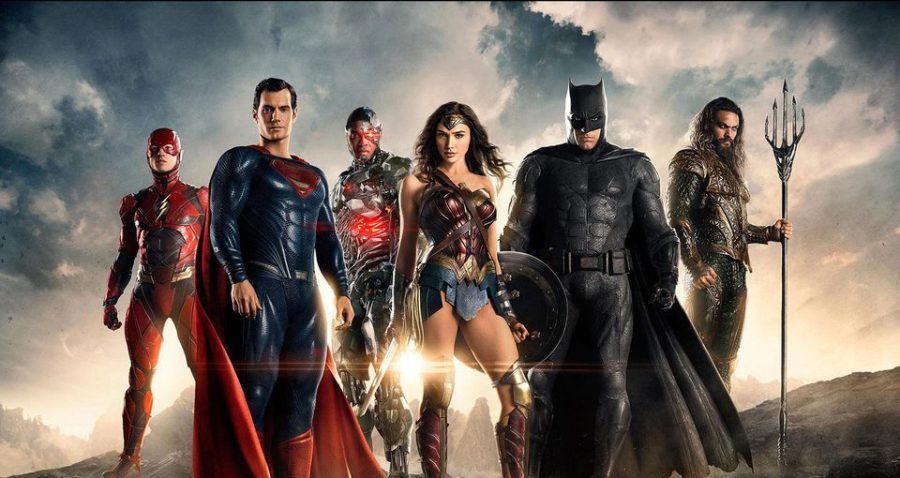Does Zach Snyder’s Justice League Do Justice to the League?
Zach Snyder’s “Justice League” only bode well for Snyder fans.
March 24, 2021
In 2017, audiences bore witness to the first-ever adaptation of The Justice League to the silver screen, and fans did not get what they were hoping for, to say the least. Plagued by reshoots, differing directorial visions and the infamous digital removal of Henry Cavill’s mustache, the film was a quippy, tonally indistinct CGI slugfest. The movie that was supposed to turn DC into Marvel’s box office equal had failed, and in its wake stood many disappointed fans. Since the beginning, Warner Brothers’ DC Extended Universe had been spearheaded by Zach Snyder, who kicked things off with “Man of Steel” in 2013 and followed by introducing Batman and Wonder Woman to Superman in 2016’s “Batman v. Superman: Dawn of Justice.” While neither film was a critical success, both movies, and more importantly their director, developed a major cult following. Snyder’s next step was to direct the 2017 “Justice League,” but he withdrew from the project in its final stages due to a family tragedy, leaving Joss Whedon to step in and finish the film. Four years later, Snyder’s fans have willed his cinematic vision into existence with “Zach Snyder’s Justice League,” released as an HBO Max exclusive this past Thursday.
The story of the film is primarily the same as its 2017 counterpart, in which Batman (Ben Affleck) and Wonder Woman (Gal Gadot) hurry to recruit a team of superheroes to face off against an encroaching alien threat from the hell-like world, Apokolips. Also consistent are the roles of league members The Flash (Ezra Miller), Aquaman (Jason Mamoa) and Cyborg (Ray Fisher) in their effort against the movie’s big bad, Steppenwolf. Where the film differs is first, and most noticeably, in its runtime, which clocks in at a whopping four hours and two minutes. With this extended runtime comes a plethora of never-before-seen character-led moments, and spoiler-alert, new characters, including the deadly Darkseid (who isn’t particularly deadly here) and the meditative Martian Mahunter (who actually is fairly meditative). Also different is the addition of Henry Cavill Superman’s black costume and alternate dialogue within pre-existing scenes from the 2017 movie.
“Zach Snyder’s Justice League” is called that for a reason, as all of the small changes from the theatrically released version add up to a sum that is distinctly Snyder’s vision. As only Snyder can do, Superman serves more as a Jesus allegory than as an actual character, and Batman is much less afraid to use guns and kill people than he should be. Everything from the action sequences to the soundtrack are very in-line with Snyder’s directorial idiosyncrasies; the music is almost always of the lyrical alternate/indie variety and almost never consistent with what is being shown on screen. The action sequences are fast-paced and play out like moving comic book pages, which are emphasized by brief slow-motion zoom-ins.
If there is one thing that Snyder is great at as a director, it is making a movie feel like a comic book. The film utilizes a very untraditional 4:3 aspect ratio that gives every shot the aesthetic of a comic book panel. Presumably, this skill for capturing the atmosphere of a comic book originates from Snyder’s practically panel-per-panel adaptation of “Watchmen” in 2009. Unfortunately, Snyder seems to have drawn more than just this from “Watchmen,” because he approaches every superhero film with the same melancholy that the 2009 movie necessitated. The Justice League is not the Watchmen, as it does not thrive in a moody atmosphere. On the other hand, The Justice League doesn’t need to be light and fun like Joss Whedon’s “The Avengers.” Considering that both Whedon and Snyder had a hand in 2017’s “Justice League,” it’s no surprise that the movie was a stylistically erratic mess. Rather than bringing a much needed balance to these two styles, “Zach Snyder’s Justice League” piles on the weight in the moody atmosphere department.
Before Marvel dominated the arena of superhero blockbusters, The Justice League was as big, if not bigger, than The Avengers. With the first attempt, “Justice League’’ a failure but, much like Superman within Snyder’s narrative, the film was given an unprecedented second chance. That being said, whether or not “Zach Snyder’s Justice League” is truly a success rests in the eyes of the beholder. Undisputedly, the film is at the very least, marginally better than DC’s first attempt, but Snyder’s vision doesn’t have the same universal appeal as Marvel’s tried and true moviemaking formula (although the four hour runtime practically prevented that from the start).
The movie being either a masterpiece or a total flop depends on the viewer’s liking or disliking of Snyder’s filmmaking style. To those who rallied for the film’s creation, “Zach Snyder’s Justice League” will be a dream come true, but for the casual watcher, not so much. Regardless of one’s thoughts on the film, the movie marks the start of an era in which fan culture holds more influence over cinema than ever before. Though DC and Warner Brothers have been adamant that there will be no followup to “Zach Snyder’s Justice League,” the inclusion of a newly shot twenty-minute epilogue suggests otherwise. Any number of years ago, this epilogue would be an unsatisfying cliffhanger, but in this new age, if fans want more, all they have to do is ask.


